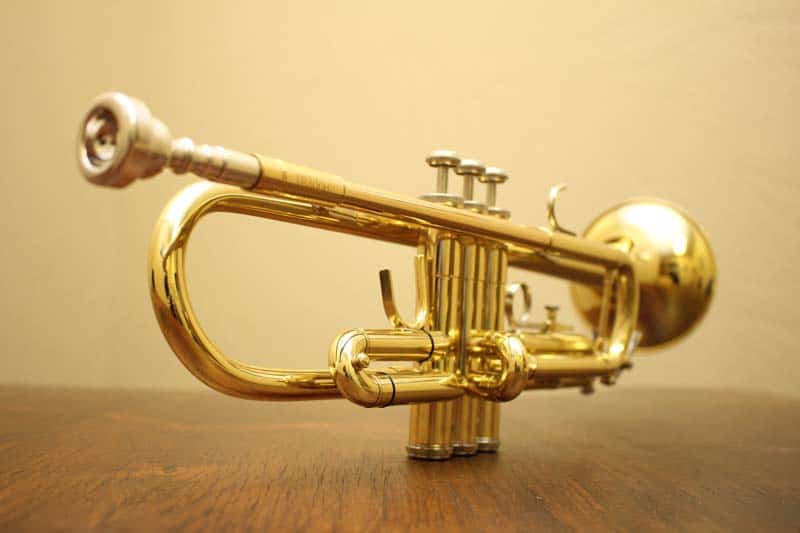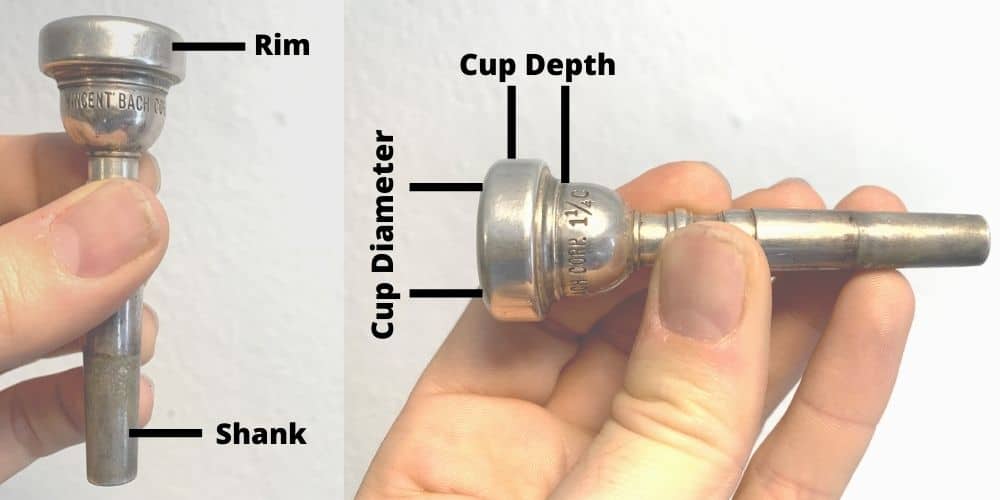The mouthpiece of a trumpet and similar brass instruments works in a very specific way that’s very unique to the brass-wind family of instruments.
Let’s dive into exactly how it works!
This is How a Trumpet Mouthpiece Works
Trumpet mouthpieces direct the buzzing sound from the lips into the lead pipe of the trumpet. It gets amplified through the pipes and the bell. The rim of the mouthpiece keeps the lips in place in order to keep a constant tone. The mouthpiece can be detached from the instrument.
Table of Contents

This technique is unique to all brasswind instruments.
This is the main technique you need to learn in order to master the trumpet. Once you can produce a good constant buzzing sound you will be on your way to become a good intermediate trumpeter.
How Does the Mouthpiece Generate a Sound?
The sound is generated with the lips.
When the lips are pressed against the rim of the mouthpiece it’s pretty easy to create the buzzing sound that is needed to play a clear tone on the trumpet.
The rim is the outer ring of the mouthpiece that you press against the lips to create the sound. The cup is the hole inside the mouthpiece.
The trumpet mouthpiece doesn’t look like much as it’s a pretty small piece of brass (typically covered with silver or gold).

How to Buzz on a Trumpet Mouthpiece?
The buzzing sound is made with the lips. It’s important to create tension between the lips by pressing them together. Beginners will typically press the mouthpiece hard against the lips to help create the buzzing sound, but actually, you don’t need to add pressure.
It’s a bad habit to press the trumpet and the mouthpiece hard against the lips, for several reasons:
- You will get tired more quickly
- You will get a “forced tone” on the trumpet
- It can have a permanent effect on the position of the teeth for young players.
Instead, you must learn to create the buzzing sound with your lips without the mouthpiece so you don’t need the pressure of the mouthpiece to form a good strong tone.
Here’s a tiny video that shows you how to create the buzzing sound:
Some people even believe that playing the trumpet makes you a better kisser!
How to Blow Into a Trumpet Mouthpiece?
When you blow into the trumpet you should have a good relaxed position of the lips against the mouthpiece before you start to blow. You form your lips like you would do if you have a piece of hair on your tongue that you’re trying to get out of your mouth.
That exercise will typically work well and most people will be able to create a good blow that will activate the buzzing sound.
Some people think you should simply blow harder into the trumpet to create the sound.
That’s not the case.
The amount of air and the amount of pressure does not help you create a good clear tone. You definitely don’t need to blow hard into the mouthpiece to play the trumpet.
The harder you blow, the louder the trumpet will play but you can actually play very silently on a trumpet as well.
You should also read this fine piece on how to play the trumpet with less lip pressure.
Can You Play the Trumpet Without a Mouthpiece?
You can play the trumpet without a mouthpiece but it doesn’t sound very good.
The mouthpiece is there to help you create a good stable sound.
However, it can be a really good exercise to play the trumpet without the mouthpiece. Just for a few minutes once in a while. Once you put the mouthpiece back on, it will immediately feel so much easier to play a good clear sound on the trumpet.
It’s an old trick I learned from a trumpet teacher and something that can be really helpful in order to learn just how little movement you need to create between the lips to make the trumpet play.
How Do You Position the Lips?
Position the mouthpiece at the center of the lips so the trumpet points straight. However, for some trumpeters, this is not possible due to the position of the front teeth, but make sure the opening between the lips is placed at the center of the mouthpiece, vertically.
Some people will find it much easier to play the trumpet if they move the mouthpiece a bit to the left or right, myself included.
This has to do with the position of the teeth.
Many professional trumpeters will position the mouthpiece a bit to the left or right and not at the center of the lips.
You should experiment with this if you find it hard to create a good tone with the mouthpiece positioned at the center of your lips.
How to Play High Notes on a Trumpet Mouthpiece?
When you want to hit the high notes on the trumpet it’s important to check a few things and to use a good technique.
First, you should make sure you use a mouthpiece that’s constructed in a way that doesn’t make it too hard to play the high notes. We’re looking for a mouthpiece with a relatively small cup size, such as the Bach 7c.
You can read more in our article here about cup sizes and how they affect the tone and pitch.
Secondly, you should make sure to void pressing the mouthpiece harder against your lips as you try to reach the upper range of tones.
Many trumpeters will press the trumpet too hard against the lips to create a tighter air passage from the lips. This is a bad strategy as your lips will get tired more quickly which is counterproductive.
Instead, make sure to train your “buzz” by adding pressure from the diaphragm. It’s all about creating a good stable stream of air with support from your lungs and diaphragm.
You can train this by paying attention to your stomach while you play. Make sure someone can give you a light push in the stomach at all times without causing you to “lose your breath”.
What About the Size of the Mouthpiece?
The size of the mouthpiece plays an important role regarding the tone and range of the trumpeter.

The bigger the cup, the more stability you will get. This is especially great for beginners as they need that extra support to help them get a stable tone.
As you get more experienced, you will benefit from switching to a mouthpiece with a slightly smaller cup.
All trumpets come with one or two mouthpieces and the size and shape of the cup varies a lot. All Bach trumpets come with a 7c mouthpiece which is a mouthpiece with a relatively small cup. This is because Bach trumpets are mainly used by intermediate and professional trumpeters.
Beginner’s models and cheaper trumpets often come with a mouthpiece that has a slightly bigger cup.
You might want to upgrade your mouthpiece as you become more experienced.
What’s the Difference Between Trumpet Mouthpieces?
The main difference is the size of the rim and the diameter and depth of the cup (check the image above for reference). The bigger the rim, the bigger the size of the cup. Mouthpieces with big rims and deep cups are for beginners or a warmer sound.
It’s easier to start out with a mouthpiece that has a rather small rim and a deep cup.
This will support the beginner to get a good clean tone without too much rash and crackly sounds.
How to Know Which Trumpet Mouthpiece to Use?
If you’re a complete beginner it’s advisable to start out with a mouthpiece such as the Bach 3c or 5c.
They are easier to use for beginners as they offer great support and a relatively larger area for the lips to produce the buzzing sound.
For people with a big mouth or big lips, it can often be a good idea to test out bigger mouthpieces such as the Bach 3c or the 1 1/2C model. These do not come standard with the instrument and you will probably have to visit a store to test them out.
All Mouths are Unique
There are not universal mouthpieces that works well for all beginners or all professionals.
Each person has to experiment a bit to find out what works best.
You simply cannot look to a professional and just copy their setup. You need to test out different mouthpieces with different cup sizes and rim sizes. That’s the only way to find the optimal mouthpiece for you.
Each trumpeter has a unique combination of teeth and lips. The position of the teeth and the size and shape of the lips means that you need to do some testing and digging before you find out what works best ofr you.
How to Fit a Trumpet Mouthpiece?
A trumpet mouthpiece will fit any trumpet. The side of the mouthpiece shank (the part you insert into the trumpet) is not standardized but it always has a smaller diameter than the leadpipe where you insert the mouthpiece.
That also means that you don’t need to check this before you purchase a new mouthpiece. Any mouthpiece should fit any trumpet.
It’s also very expensive to have a mouthpiece worked on in order to change the size of the rim or the size and shape of the cup.
It’s cheaper to buy an additional mouthpiece.
What is the Best Trumpet Mouthpiece?
There’s no overall winner when it comes to trumpet mouthpieces. Each trumpeter has to do some testing to find out what works best. The most used mouthpiece is the Bach 7c because it comes standard with most Bach trumpets.
In other words, you have to try different mouthpieces in order to find your optimal setup.
It’s a good idea to switch mouthpieces with fellow trumpeters to see how they work for you.
It’s typically not enough to try it on for a minute or two, you need to use it for a while in order to compare it to the mouthpiece you currently use.
